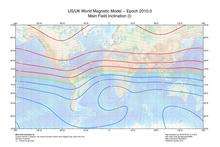Magnetic dip

Magnetic dip, dip angle, or magnetic inclination is the angle made with the horizontal by the Earth's magnetic field lines. This angle varies at different points on the Earth's surface. Positive values of inclination indicate that the magnetic field of the Earth is pointing downward, into the Earth, at the point of measurement, and negative values indicate that it is pointing upward. The dip angle is in principle the angle made by the needle of a vertically held compass, though in practice ordinary compass needles may be weighted against dip or may be unable to move freely in the correct plane. The value can be measured more reliably with a special instrument typically known as a dip circle.
Dip angle was discovered by the engineer Georg Hartmann in 1544.[1] A method of measuring it with a dip circle was described by Robert Norman in England in 1581.[2]
Explanation

Magnetic dip results from the tendency of a magnet to align itself with lines of force. As the Earth's magnetic lines of force are not parallel to the surface, the north end of a compass needle will point downward in the northern hemisphere (positive dip) or upward in the southern hemisphere (negative dip). The range of dip is from −90 degrees (at the South Magnetic Pole) to +90 degrees (at the North Magnetic Pole). Contour lines along which the dip measured at the Earth's surface is equal are referred to as isoclinic lines. The locus of the points having zero dip is called the magnetic equator or aclinic line.[3]
Practical importance
The phenomenon is especially important in aviation, as it causes the airplane's compass to give erroneous readings during banked turns and airspeed changes. The latter errors occur because the compass card tilts on its mount when under acceleration.[4]
Compass needles are often weighted during manufacture to compensate for magnetic dip, so that they will balance roughly horizontally. This balancing is latitude-dependent; see Compass balancing (magnetic dip).
See also
![]() Geomagnetism – Wikipedia book
Geomagnetism – Wikipedia book
References
- ↑ Charles Murray (2003). Human Accomplishment (First ed.). p. 176.
- ↑ Norman, Robert (1581). The newe attractive: shewing the nature, propertie, and manifold vertues of the loadstone: with the declination of the needle, touched therewith under the plaine of the horizon.
- ↑ James Wood, ed. (1907) [1900]. "Aclinic Line". The Nuttall Encyclopædia.
- ↑ Instrument Flying Handbook: FAA-H-8083-15B. Federal Aviation Administration, US Department of Transportation. 2014. pp. 5–13,5–14.